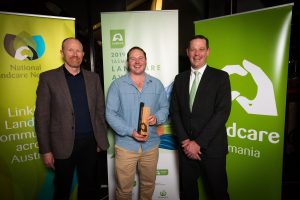Soil health practices land Tasmanian farmer national award
Each year, the National Landcare Awards acknowledge and celebrate local Landcare achievements at state and territory level as well as nationally. In 2021, Tasmanian farmer Michael Nichols from Redbank Farm took home the Australian Government Innovation in Agriculture Land Management Award. VegNET – Tasmania Regional Development Officer Ossie Lang speaks to Michael about the operation’s innovations and his recent achievements.
Michael Nichols runs a 165-hectare farming operation at Sisters Creek in north-western Tasmania. Redbank Farm has a five to six year cropping rotation with onions, potatoes, peas, poppies, wheat and corn. Michael also fattens beef steers and has some pine plantations. This type of mixed farming is typical for many vegetable producing businesses in Tasmania.
Additionally, he owns a grain dryer and silos on-site where he takes in grain from local growers – as well as his own – and markets it to local dairy operations.
The corn has been a relatively recent addition to the rotation, and Michael is still trialling varieties to determine what suits his growing conditions. The corn, when blended with the wheat, is a useful lead feed alternative for his dairy clients. Corn is a good rotational crop with other vegetables.

Michael also regularly uses cover crops, not only to avoid erosion and suppress weeds, but also as a biofumigant. Alongside this, Michael’s father runs an extensive chicken hatchery operation on the property.
Celebrating innovation
On 5 August 2021, Michael took home the Australian Government Innovation in Agriculture Award at a function held in Hobart. This followed the state award that he received in 2019 at the Landcare Tasmania awards.
While Michael is innovative in a number of ways, the national award was for the work he undertook in adopting precision ag approaches, reducing his yield variation through soil mapping and variable rate applications of fertiliser and other inputs.
Michael had his land sampled and soil tested with two tests per hectare. The analyses included soil pH and nutrients potassium (K), calcium (Ca), magnesium (Mg) and phosphorous (P). Michael then used this information to create variable rate maps for his various inputs, lime to adjust pH and single super to adjust P variability issues.
Michael has also combined this variable rate approach with in-season monitoring to vary his Nitrogen (N) applications to match crop needs. He has done this using NDVI imagery – either by satellite or drone –through the growing period to check for variation between areas of lighter and darker green foliage in the crop.
Positive outcomes
The success of this variable rate management has been confirmed in those crops where Michael is able to monitor the yield across the paddock.
“Before commencing this program, we would see a (within field) yield variation of around 40 per cent. We’ve been able to reduce this down to around 20 per cent using variable rate technologies,” Michael explains.
The variable rate approaches have also paid off in reduced fertiliser costs.
“In one instance, I was able to scale back the rate to around a quarter of the recommended rate in certain areas. This reduced fertiliser cost was achieved while getting a yield increase from the crop,” Michael says.

Several other benefits, which are a result of a more consistent crop across the paddock, aren’t as easy to pin a dollar figure on. A more even crop makes spray application, nutrition, and other crop management decisions much easier to get right, as there is less variation in the plant growth stage and vigour.
Michael has also seen reductions in disease incidence as the areas with high nutrient loads, lush growth and other favourable conditions for diseases have decreased.
So, what next for Redbank Farm?
“At the moment, irrigation decisions are being made for a paddock based of a single probe or data point. I’d like to apply a similar area sampling type method to moisture monitoring and irrigation to better inform irrigation decisions,” Michael says, adding he is also interested to see how sap testing across a paddock could back up the variable rate nutrition decisions.
Find out more
For further details about how to use variable rate approaches, please contact Ossie Lang via email at ossiel@rmcg.com.au or on 0430 380 414.
Follow us on social media: Facebook: @VegNET.Tas and Twitter: @VegNET_Tas.
VegNET 3.0 is a strategic levy investment under the Hort Innovation Vegetable Fund.
This project has been funded by Hort Innovation using the vegetable research and development levy and contributions from the Australian Government.
Project Number: VG21000
Cover image: Michael Nichols pictured discussing his operation with horticulture students. Images courtesy of Theresa Chapman.

